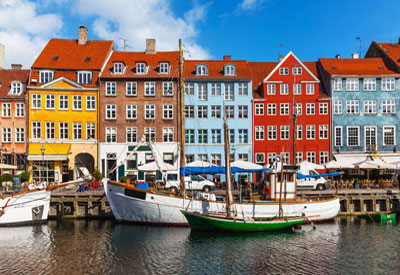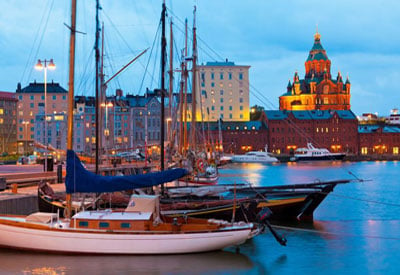Denmark is a Scandinavian country in Northern Europe. The country of Denmark, together with Greenland and the Faroe Islands, comprises the Kingdom of Denmark. It is the southernmost of the Nordic countries, southwest of Sweden and south of Norway, and bordered to the south by Germany. Denmark borders both the Baltic and the North Sea. The country consists of a large peninsula, Jutland (Jylland) and many islands, most notably Zealand (Sjælland), Funen (Fyn), Vendsyssel-Thy (commonly considered a part of Jutland), Lolland, Falster and Bornholm, as well as hundreds of minor islands often referred to as the Danish Archipelago. Denmark has long controlled the approach to the Baltic Sea; before the digging of the Kiel Canal, water passage to the Baltic Sea was possible only through the three channels known as the “Danish straits”.
Denmark is a constitutional monarchy with a parliamentary system of government. Denmark has a state-level government and local governments in 98 municipalities. Denmark has been a member of the European Union since 1973, although it has not joined the Eurozone. Denmark is a founding member of NATO and the OECD. Denmark is also a member of the Organization for Security and Cooperation in Europe (OSCE).
Denmark, with a mixed market capitalist economy and a large welfare state, ranks as having the world’s highest level of income equality. Denmark has the best business climate in the world, according to the U.S. business magazine Forbes. From 2006 to 2008, surveys ranked Denmark as “the happiest place in the world”, based on standards of health, welfare and education. Gallup polls between 2005 and 2009 also ranked Denmark the happiest nation. The 2009 Global Peace Index survey ranks Denmark as the second most peaceful country in the world, after New Zealand. In 2009, Denmark was ranked as one of the least corrupt countries in the world according to the Corruption Perceptions Index, ranking second only to New Zealand. In 2010, Transparency International ranked it as the least corrupt country in the world, in a three-way tie with New Zealand and Singapore. Denmark remained consistent in the ‘Corruption Perceptions Index”, perceived as “very clean” country, second on the 2011 list and garnering the top 1 rank along with Finland in the 2012.
In this Country Profile
The national language, Danish, is closely related to Swedish and Norwegian, with which it shares strong cultural and historical ties. 80.9% of the inhabitants of Denmark are members of the Lutheran state church. As of 2010, 548,000 persons (9.9% of the Danish population) were either immigrants or descendants of recent immigrants. Most of these (54%) have their origins in Scandinavia or elsewhere in Europe, while the remainder originate mainly from Middle Eastern and African countries.
:: Background of Denmark ::
Once the seat of Viking raiders, and later a major north European power, Denmark has evolved into a modern, prosperous nation that is participating in the general political and economic integration of Europe. It joined NATO in 1949 and the EEC (now the EU) in 1973. However, the country has opted out of certain elements of the European Union’s Maastricht Treaty, including the European Economic and Monetary Union (EMU), European defense cooperation, and issues concerning certain justice and home affairs.
:: Geography of Denmark ::
Location: Northern Europe, bordering the Baltic Sea and the North Sea, on a peninsula north of Germany (Jutland); also includes two major islands (Sjaelland and Fyn)
Geographic coordinates: 56 00 N, 10 00 E
Area:
total: 43,094 sq km
land: 42,434 sq km
water: 660 sq km
note: includes the island of Bornholm in the Baltic Sea and the rest of metropolitan Denmark (the Jutland Peninsula, and the major islands of Sjaelland and Fyn), but excludes the Faroe Islands and Greenland
Area – comparative: slightly less than twice the size of Massachusetts
Land boundaries: 68 km
Border countries: Germany 68 km
Coastline: 7,314 km
Maritime claims:
territorial sea: 12 nm
contiguous zone: 24 nm
exclusive economic zone: 200 nm
continental shelf: 200 m depth or to the depth of exploitation
Climate: temperate; humid and overcast; mild, windy winters and cool summers
Terrain: low and flat to gently rolling plains
Elevation extremes:
lowest point: Lammefjord -7 m
highest point: Mollehoj/Ejer Bavnehoj 171 m
Natural resources: petroleum, natural gas, fish, salt, limestone, chalk, stone, gravel and sand
Land use:
arable land: 52.59%
permanent crops: 0.19%
other: 47.22% (2005)
Irrigated land: 4,490 sq km (2003)
Total renewable water resources: 6.1 cu km (2005)
Freshwater withdrawal (domestic/industrial/agricultural):
total: 0.67 cu km/yr (32%/26%/42%)
per capita: 123 cu m/yr (2003)
Natural hazards: flooding is a threat in some areas of the country (e.g., parts of Jutland, along the southern coast of the island of Lolland) that are protected from the sea by a system of dikes
Environment – current issues: air pollution, principally from vehicle and power plant emissions; nitrogen and phosphorus pollution of the North Sea; drinking and surface water becoming polluted from animal wastes and pesticides
Environment – international agreements: party to: Air Pollution, Air Pollution-Nitrogen Oxides, Air Pollution-Persistent Organic Pollutants, Air Pollution-Sulfur 85, Air Pollution-Sulfur 94, Air Pollution-Volatile Organic Compounds, Antarctic Treaty, Biodiversity, Climate Change, Climate Change-Kyoto Protocol, Desertification, Endangered Species, Environmental Modification, Hazardous Wastes, Law of the Sea, Marine Dumping, Marine Life Conservation, Ozone Layer Protection, Ship Pollution, Tropical Timber 83, Tropical Timber 94, Wetlands, Whaling; signed, but not ratified: none of the selected agreements
Geography – note: controls Danish Straits (Skagerrak and Kattegat) linking Baltic and North Seas; about one-quarter of the population lives in greater Copenhagen.
:: People of Denmark ::
Population: 5,529,888 (July 2011 est.)
Age structure:
0-14 years: 17.6% (male 500,265/female 474,829)
15-64 years: 65.3% (male 1,811,198/female 1,798,507)
65 years and over: 17.1% (male 417,957/female 527,132) (2011 est.)
Median age:
total: 40.9 years
male: 40 years
female: 41.8 years (2011 est.)
Population growth rate: 0.251% (2011 est.)
Birth rate: 10.29 births/1,000 population (2011 est.)
Death rate: 10.19 deaths/1,000 population (July 2011 est.)
Net migration rate: 2.41 migrant(s)/1,000 population (2011 est.)
Urbanization:
urban population: 87% of total population (2010)
rate of urbanization: 0.4% annual rate of change (2010-15 est.)
Sex ratio:
at birth: 1.055 male(s)/female
under 15 years: 1.05 male(s)/female
15-64 years: 1.01 male(s)/female
65 years and over: 0.78 male(s)/female
total population: 0.98 male(s)/female (2011 est.)
Infant mortality rate:
total: 4.24 deaths/1,000 live births
male: 4.3 deaths/1,000 live births
female: 4.18 deaths/1,000 live births (2011 est.)
Life expectancy at birth:
total population: 78.63 years
male: 76.25 years
female: 81.14 years (2011 est.)
Total fertility rate: 1.74 children born/woman (2011 est.)
HIV/AIDS – adult prevalence rate: 0.2% (2009 est.)
HIV/AIDS – people living with HIV/AIDS: 5,300 (2009 est.)
HIV/AIDS – deaths: fewer than 100 (2009 est.)
Nationality: noun: Dane(s) adjective: Danish
Ethnic groups: Scandinavian, Inuit, Faroese, German, Turkish, Iranian, Somali
Religions: Evangelical Lutheran 95%, other Christian (includes Protestant and Roman Catholic) 3%, Muslim 2%
Languages: Danish, Faroese, Greenlandic (an Inuit dialect), German (small minority)
note: English is the predominant second language
Literacy:
definition: age 15 and over can read and write
total population: 99%
male: 99%
female: 99% (2003 census)
School life expectancy (primary to tertiary education):
total: 17 years
male: 16 years
female: 18 years (2008)
Education expenditures: 7.9% of GDP (2006)


Sorry, the comment form is closed at this time.